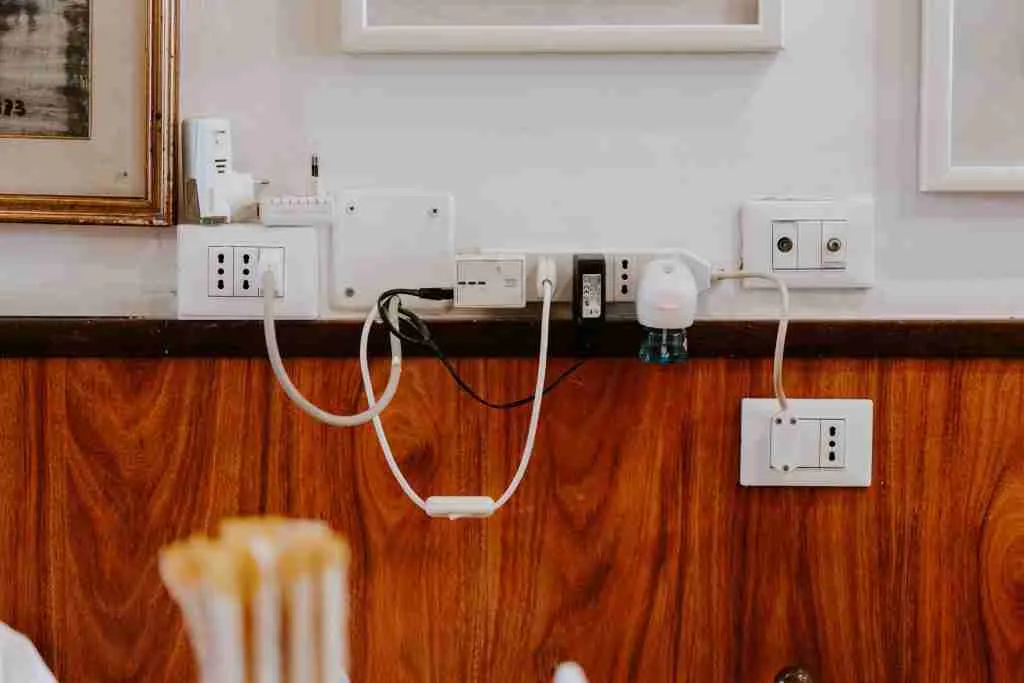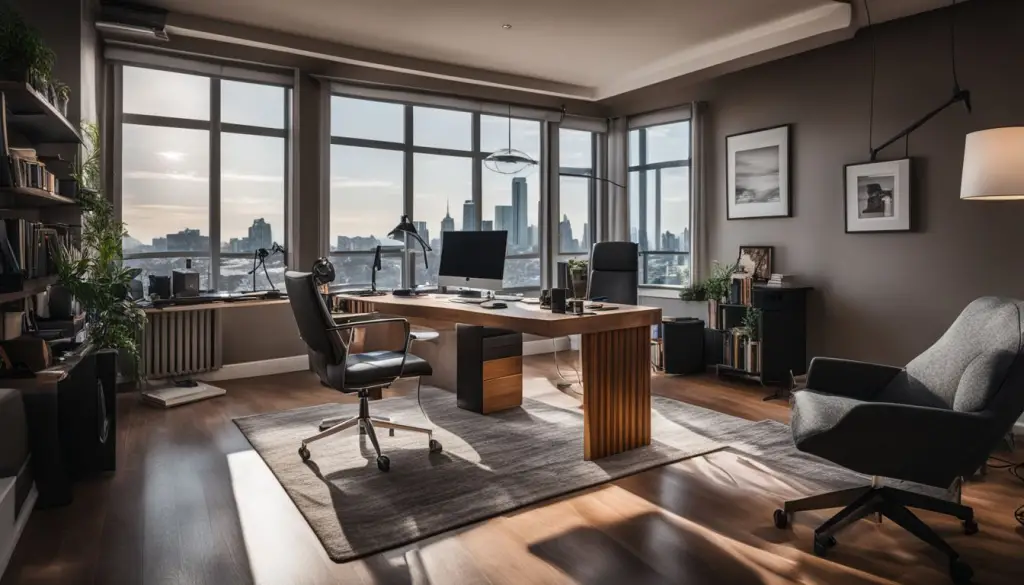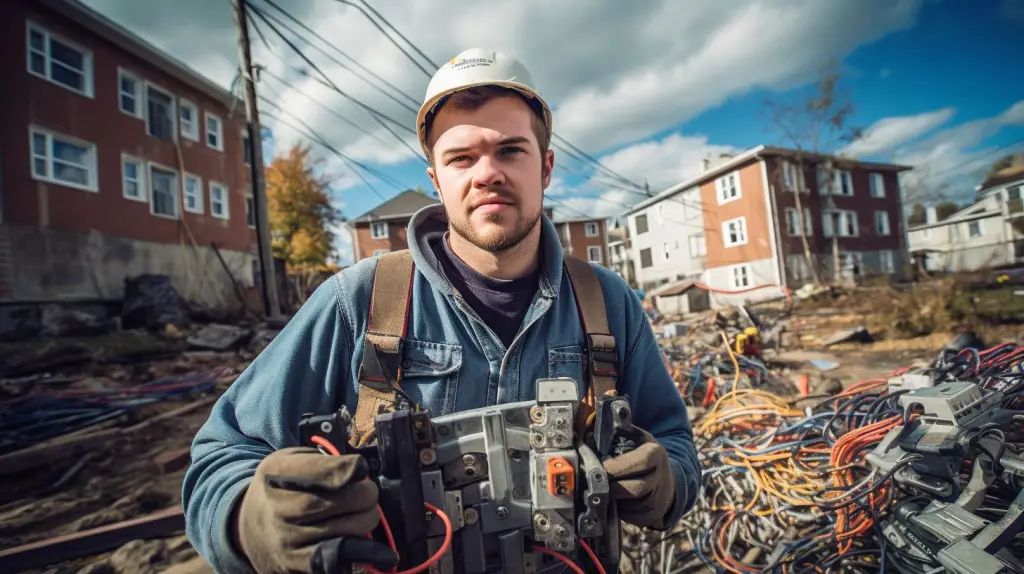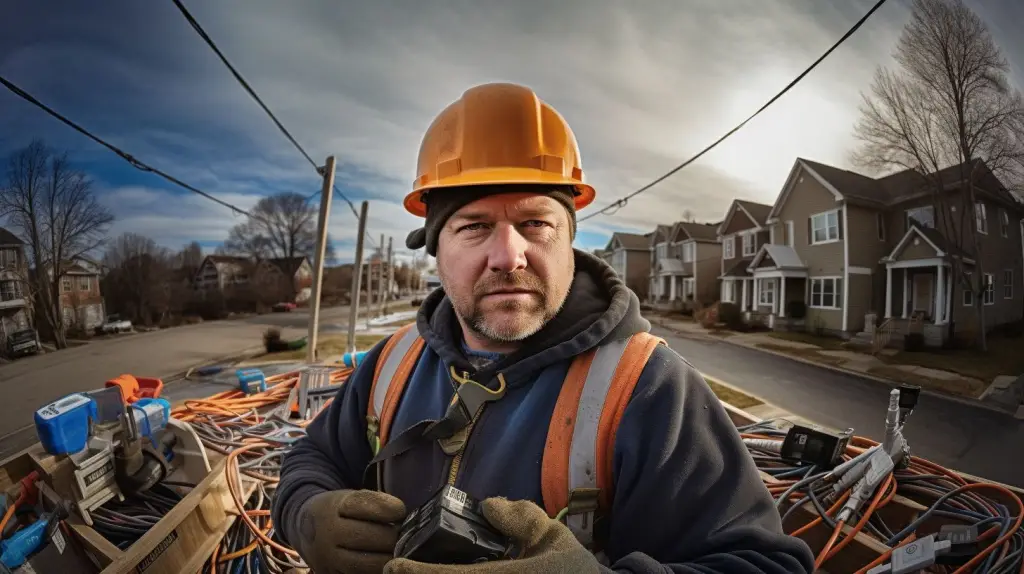Ever wondered how many electrical outlets you need per room in your home? You’re not alone – it’s a common question asked during major home renovations or even when just moving into a new place.
This blog will shed light on the ideal number of sockets needed for different rooms, from the kitchen to the bedroom, based on US regulations and safety considerations. Excited to learn more? Let’s plug into this essential guide!
Contents
ToggleKey Takeaways
- The number of electrical outlets needed in a room depends on its size, usage, and power consumption of appliances.
- Kitchens usually require 6 to 10 of them due to the presence of multiple appliances.
- Living rooms should have sockets every 6 feet for safety and to prevent overloading circuits.
- Bedrooms typically need four to six outlets for convenience and to avoid overloading one with too many devices.
- Bathrooms require an outlet every 6 feet to power grooming tools safely.
- A standard 20 Amp breaker can handle up to 10 outlets, but it’s important not to exceed the recommended load.
Understanding Electrical Outlets

Electrical outlets give power to our devices. They have small holes where plugs fit in. Each hole is a slot, with one bigger than the other. The bigger slot is “neutral” and the smaller one is “hot”.
A third-round hole you often see below these two slots is for grounding.
Power flows from the hot slot through your device and back into the neutral slot. The ground hole keeps you safe if anything goes wrong with this flow. This type of socket is common in homes for safety reasons and meets most US regulations.
In big rooms, we use more of them because there are more wall spaces available. If a room size is about 12 x 14 feet, it would need four to six according to standard rules.
Perfect Number of Outlets in Different Rooms

– The number of outlets in a room should be based on the specific needs and power consumption of that particular area.
Kitchen
The cooking area is often a busy room. Everybody uses it to cook and often to eat too. It’s full of machines that need power. A fridge, an oven, a microwave are all usual things in kitchens these days.
For this reason, you need a lot of sockets. The wall length you have decides how many you can fit in.
A mid-sized one usually needs 6 to 10 wall sockets. This does not count what goes on the countertops! But be careful not to stress your delay line too much or they could overheat.
Overheating can cause fires which would be very bad news for your safe home life!
Living Room
The living area is a busy place. It needs sockets every 6 ft along the floor line for safety. More wall sockets may be needed based on the number of devices in the room. Overloading a circuit can cause overheating and might lead to a fire. For instance, if you notice issues like ceiling fan lights flickering, it could be a sign of an overloaded circuit.
Check local or national electric codes and think about how much power your devices use. This will ensure you don’t overload your delay and keep your room safe.
Bedroom
In your sleeping room, you need about four to six of them. These should be placed every six feet along the walls. This way, no matter where you are in the room, an outlet is close by. Look at how many devices you use in your room.
That can help decide how many sockets to have. Making sure there are enough sockets also keeps people from overloading one with too many things plugged in.
Bathroom
Bathrooms require a wall plug for every 6 feet of wall area. This ensures that there are enough outlets to power all the necessary devices in the bathroom, such as hair dryers, electric razors, and other grooming tools.
It’s essential to follow this guideline to prevent overloading the circuit and ensure safe operation. Always consult national electrical codes and consider the power consumption of the devices plugged into the plugs when determining how many of them you need in your restroom.
How Many Outlets Can a 20 Amp Breaker Handle?

A standard 20-Amp breaker can handle up to 10 electrical sockets. It is important not to exceed 80% of the maximum suggested load, as overloading a circuit can lead to overheating and potential fire hazards.
To prevent this, it is recommended to consult a professional electrician who can ensure proper spacing and placement of electrical outlets throughout your home.
Factors Determining the Number of Outlets per Room

In this case, factors such as room size, usage, and power consumption of appliances determine how many electrical outlets per room you actually need.
Room Size
The size of a room plays a crucial role in determining the number of wall sockets needed. Larger rooms require more to ensure convenient access to power from different areas.
This is especially important in spacious living areas or open-plan cooking islands where multiple appliances and devices are used simultaneously. Smaller rooms, like restrooms or closets, may not need as many since they typically have fewer electrical appliances plugged in at once.
It’s essential to consider the dimensions of each room when planning the placement and quantity of electrical outlets for optimal functionality and convenience.
Room Usage
Different rooms in a house have different purposes, which affects the number of wall plugs they need. For example, kitchens are often busy places with lots of gadgets, washing machines, and dryers, so they require more of them than other rooms.
Living areas are where we relax and entertain, so having enough sockets for lamps, televisions, and charging devices is important. Bedrooms need them for bedside lamps and charging phones while bathrooms typically only need a few for things like hair dryers or electric toothbrushes.
Considering how each room will be used helps determine the perfect number of sockets needed to meet our electrical needs efficiently and safely.
Power Consumption of Appliances
Appliances vary in how much power they consume. Some major appliances, like refrigerators and air conditioners, use more electricity than others, such as lamps or small electronics. It’s important to consider the power consumption of your appliances when choosing the number of outlets per room.
By understanding the wattage requirements of your devices and consulting local codes, you can ensure that you have enough sockets to safely accommodate all of your electrical devices without overloading.
This will help prevent electrical issues and keep your home running smoothly.
Testing Outlet Capacity with Multimeters
To determine the safe number of sockets on a circuit, you can test the capacity using a multimeter. Here are the steps:
- Turn off the power: Before testing, make sure to turn off the power supply to the outlet by flipping the breaker switch.
- Set up the multimeter: Set your multimeter to measure AC voltage.
- Test voltage at the outlet: Insert one probe into the smaller slot and the other probe into the larger one. The multimeter should display a reading close to 120 volts for a standard electrical outlet.
- Test voltage under load: Connect a device with known wattage, such as a lamp or a small appliance, to the outlet. Measure the voltage again while the device is running. The voltage reading should remain close to 120 volts.
- Calculate amps per outlet: Divide the wattage of your device by 120 volts to calculate its amperage draw. For example, if your device uses 600 watts, it would draw 5 amps (600 watts / 120 volts = 5 amps).
- Determine maximum outlets per breaker: To prevent overloading, divide the maximum amp rating of your breaker (e.g., 15 or 20 amps) by the amperage draw per outlet determined in step 5 (e.g., 1.5 amps). This will give you an estimate of how many outlets can be safely connected.
Safety Considerations in Outlet Distribution
It’s important to consider safety when distributing electrical outlets in a room. One key factor is to avoid overloading the circuit. Each outlet is connected to a specific delay line breaker, which has a maximum capacity it can handle.
If you have too many devices plugged into one outlet or multiple outlets on the same delay line, it can lead to an overload and potentially cause a fire hazard.
Another consideration is the placement of sockets near water sources, such as in restrooms and cooking areas. These places require special precautions due to the risk of electric shock. Outlets should be equipped with ground fault circuit interrupters (GFCIs), which are designed to quickly shut off power if there is any deviation in electrical current, preventing electrocution.
Additionally, it’s important to ensure that they are properly grounded and installed by a professional who follows government codes and requirements. Faulty wiring or improper installation can increase the risk of electrical glitches, shocks, or fires.
By keeping these safety considerations in mind when distributing wall plugs throughout your home, you can help protect yourself and your family from potential hazards related to electricity.
Warning Signs of an Overloaded Electrical Circuit
Signs of an overloaded delay line can be dangerous and should not be ignored. Here are some warning signs to look out for:
- Flickering or dimming lights: If your lights constantly flicker or dim, it could be a sign that your delay is being overloaded.
- Strange sounds from outlets: Buzzing, crackling, or popping sounds coming from your outlets can indicate that they are being stressed due to excessive load.
- Issues with fuses: Frequently blown fuses or tripped delay line breakers may suggest that your circuit is unable to handle the current demand.
- Lack of power in devices: If your appliances or electronic devices are not getting enough power or keep shutting off unexpectedly, it could be due to an overloaded delay line.
- Electrical shocks: Experiencing mild electric shocks when touching switches, outlets, or devices can indicate a problem with the delay line.
Conclusion
In conclusion, it’s important to have the right number of outlets in each room. Following US building regulations, rooms should have at least one outlet every 6 feet of wall space.
Kitchens, living rooms, bedrooms, and toilets all require a sufficient number of outlets for safety and convenience. Overloading delay can be dangerous, so it’s crucial to distribute the load properly and avoid plugging too many devices into a single outlet.
Hiring a professional electrician for major home renovations or rewiring projects is always recommended to ensure compliance with codes and regulations.
FAQs
1. What is the ideal number of electrical outlets per room?
The perfect number of electrical sockets in each room varies. For safety, you should avoid overloading delay and having too many devices plugged into a single outlet.
2. How can I know if my circuit is overloaded?
Signs of an overloaded delay line include issues with lighting, strange sounds from electrical socket, devices lacking power, and overheating delay.
3. Should I hire a home inspector to check my electrical installations?
Yes! A home inspector can verify if your outlet spacing meets the government-prescribed minimum standard height for light switches and socket boxes.
4. Are kitchen electrical outlets different from those in other rooms?
Yes! Kitchen countertop sockets should be placed every four feet on countertops for easy use of kitchen appliances without extension cords that may cause safety risks.
5. Can adding more receptacle outlets help prevent home fires caused by electrical glitches?
Yes! Adding more receptacle sockets reduces the need for extension cords which can overload your system and lead to fires.
6. Is bathroom outlet placement important for safety?
Absolutely! The right placement helps prevent accidents involving water and electricity while also ensuring appliances function correctly without strain on the system.























































